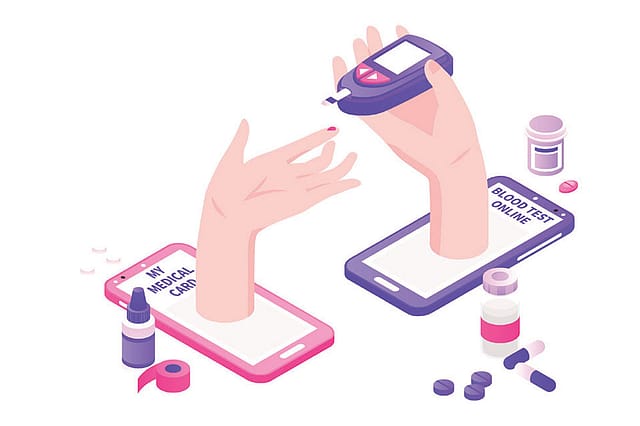The Doctor Zooms In

INDIA IS RIGHT in the midst of the Covid-19 storm as I write this. While the focus is on the pandemic, we cannot afford to ignore non-Covid patients. Let's take the example of a chronic condition like diabetes. When the outbreak first happened, our guidance to patients was to not come to the hospital for a routine checkup, to stay indoors. If you are over 60, you are at an even greater risk, so remain indoors. As it became clear that the virus is here to stay, questions started arising about routine care for diabetes. India has 77 million diabetics. It is the leading cause of blindness, heart attacks, kidney failure and amputation, among others. Not only that, uncontrolled diabetes probably puts the patient at a higher risk of contracting Covid-19, and certainly leads to poorer outcomes if the person does get infected.
With patients unable to visit their doctor, the importance of virtual or teleconsultation is greater than ever before. Fortunately, care of routine diabetes (and most endocrine disorders like thyroid) lends itself to telemedicine. The word 'telemedicine' literally means medicine at a distance. Numerous modalities are available: SMS, WhatsApp, email, even phone calls. Some are asynchronous: like responding to an email or a message within a specified period, often 48-72 hours. Some are real time: like an app-based videocall.
I was among the earliest in the country to offer professional email advice via my website. (It got featured in the BMJ more than 15 years ago!) With the Covid-19 crisis, I have adopted the use of video consultation via apps. Video consultations are undoubtedly a boon and allow one to come face-to-face with the patient while being miles apart. A huge advantage is the saving of time and money for the patient—no travel, nowaiting in crowded clinics. If you live in a different city or country, it gives you easy access to your doctor. Even if you are in the same city, you can avoid endless traffic jams. You get advice sitting in the comfort of your home or office without missing work. But there are challenges in video consultations, and I will list some of them here:
2026 New Year Issue
Essays by Shashi Tharoor, Sumana Roy, Ram Madhav, Swapan Dasgupta, Carlo Pizzati, Manjari Chaturvedi, TCA Raghavan, Vinita Dawra Nangia, Rami Niranjan Desai, Shylashri Shankar, Roderick Matthews, Suvir Saran
1) Lack of willingness: There is an inherent apprehension in many patients that a remote consultation is incomplete. They would rather wait to see the doctor in his clinic than venture into uncharted territory.
2) Use of technology: Regardless of the smartphone revolution, many of our patients are not comfortable with technology. This especially applies to those from my generation (above 60). It's not an unusual scene to have a young man in Pune or Bengaluru take an appointment for his parents located in Gorakhpur or Ranchi. And ultimately having to resort to a WhatsApp conference call to complete the consultation. Some of our kindest, sweetest, most loyal patients fall in this category.
3) Poor connectivity: Connectivity is still an issue in many parts of the country. Not everyone has a Wi-Fi at home.
4) Poor preparation: A prerequisite of telemedicine is to have the following information ready: symptoms, last prescription, list of medicines and the last test results. Many patients are not aware of their medications. We request them to take pictures of their medicines and send them to us on WhatsApp.
5) First consultation: For those who have not consulted us earlier, it is an even bigger challenge. While it is fine to give an opinion and suggest the way forward, at times it can be difficult for the doctor to provide a detailed final prescription. And most certainly it hinders building of rapport between patient and doctor.
6) Complex/injectable therapies: Initiating insulin via video is neither easy nor recommended. How does one deal with a pregnant diabetes patient for whom initiating insulin is mandatory?
All these are added to the basic shortcomings of a virtual consultation—lack of physical examination being the most important among them. Inability to examine the feet and eyes is a problem for which there is no satisfactory answer as yet.
Overcoming these obstacles requires a team effort! My secretary explains the use of the app to the patient at the time of taking an appointment. Patients upload their recent reports and chief symptoms. One of my team members summarises the case. At an appointed time I videocall the patient for consultation. I write the prescription and send it electronically. My diabetes educator then connects with them to complete her part of the consultation. I realise that not every doctor has a team, but I am happy that we have been able to establish a smooth and effective mechanism for remote consultation.
My patients over the years have become my friends, my family. I share their worries and their happiness, their sorrows and their joy. Let's reinforce this faith in each other by overcoming the challenges that the Covid-19 pandemic has thrust upon us and make optimum use of technology for connecting and communicating.
